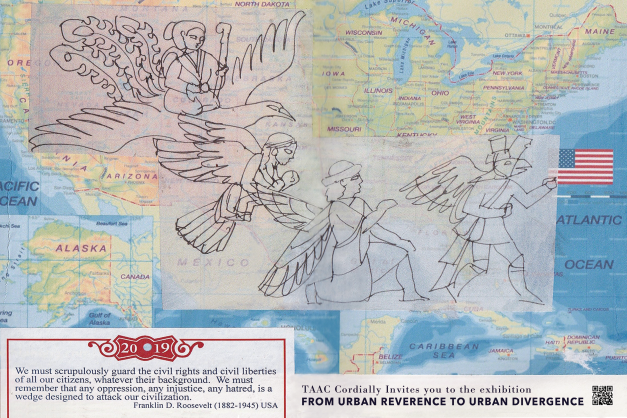Urban Divergence
From Urban Reverence to Urban Divergence
Two Sites for Exhibition:
Exhibition venue 1: Old Pfizer Building, Williamsburg
Exhibition dates: June 10 through July 23, 2022
direction: google map
open hours: Wednesday to Saturday noon - 6pm
Exhibition venue 2: Valerie Goodman Gallery
Exhibition dates: June 24 through July 23, 2022
315 East 91st Street, 1st floor, New York, NY 10128
direction: google map
Gallery hours: Monday to Friday 10:30am-5pm & by appointment
Curatorial team:
Luchia Meihua Lee (Chief Curator)
co-curators: Jennifer Pliego, Sarah Walko
Participating artists:
Herberto Turizzo Anaya
Stephanie Cheung
Chih Hui Chuang
Dennis RedMoon Darkeem
Felipe Galindo
Sarah Haviland
Diana Heise
Hsiao Chu Hsia
Hiroshi Jashiki
Mingjer Kuo
Catherine Lan
Lee Wei
Lin Shih-Pao
Eleng Luluen
j. maya luz
Walis LaBai (Diing-wuu Wu)
Sarah Walko
Wu Chien-Hsing
Yeh Fang
Rosalía Mowgli
(June 24, Upper Eastside Manhattan/Williamsburg, Brooklyn, NYC) TAAC announces after two years of postponement due to the pandemic, the From Urban Reverence and Urban Divergence exhibition finally opened in-person to the public in two venues. Join efforts from 20 multi-disciplinary artists in this exhibition. The first venue is Williamsburg’s old Pfizer building on the 1 and 5th floors; the 2nd venue is the Valerie Goodman Gallery on the upper eastside of Manhattan.
The series of Urban Tribes projects started in 2018 to examine from an art perspective the phenomenon of migrants forming an international cross-cultural "urban tribe" – one of the genres at the turn of the 21st century. The discourse thus moves to valuing human nature, preserving multiple cultures, renewing the environment, and honoring the new multi-faceted unity. Potential political, economic, and cultural crises can be averted only by an emphasis on the diversity of life that promotes interactive relationships.
Curator Luchia Lee said: “More broadly, the planet and symbiosis and mutual benefit involve the survival of human beings and the coexistence and maintenance of balance between our environment and various living things. In the ‘One Health’ initiative, human health is closely related to the health of surrounding creatures and the earth. It is a collaborative, cross-sectoral, and interdisciplinary approach at the local, regional, national, and global levels, recognizing the interlinkages between people, animals, plants, and their shared environment.”
Perhaps the most dramatic change in the transition from the village to the urban environment is the loss of cultural rituals and myths, or more precisely the need to adapt this group of human needs to the environmental changes encountered. Art creators are best able to mediate new connections to urban life.
Artists in this contemporary expression might inscribe the ambivalences and complexities of existential agon, of voice, of the affective root, or cultural difference. They might even suggest in critique or acknowledgement a mockery, a type of self-reflexive awareness.
Immersing ourselves in nature is the only way to answer two simple but indispensable questions. How do we know what we want? How much is enough? The ritual and symbolic nature of the urban tribe has become a gateway to the sounds of nature and individuals and groups. This may seem to run counter to the plans of capitalism and consumer culture, but it is a necessity. What does it mean to be part of a metropolitan tribe?



